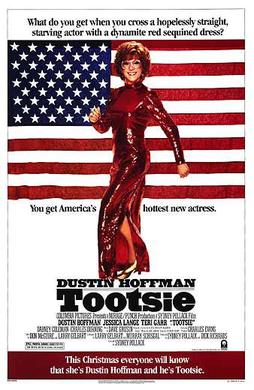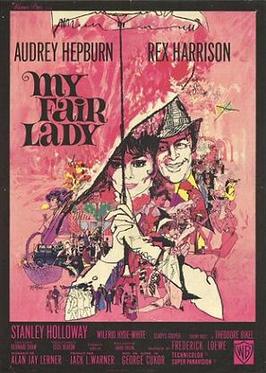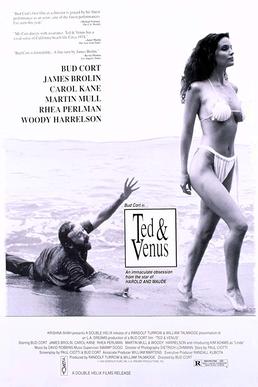
Ruth Gordon Jones was an American actress, playwright and screenwriter. She began her career performing on Broadway at age 19. Known for her nasal voice and distinctive personality, Gordon gained international recognition and critical acclaim for film roles that continued into her 70s and 80s. Her later work included performances in Rosemary's Baby (1968), What Ever Happened to Aunt Alice? (1969), Where's Poppa? (1970), Harold and Maude (1971), Every Which Way But Loose (1978), Any Which Way You Can (1980), and My Bodyguard (1980).

Tootsie is a 1982 American satirical romantic comedy film directed by Sydney Pollack from a screenplay by Larry Gelbart and Murray Schisgal and a story by Gelbart and Don McGuire. It stars Dustin Hoffman, Jessica Lange, Teri Garr, Dabney Coleman, and Charles Durning. In the film, Michael Dorsey (Hoffman), a talented actor with a reputation for being professionally difficult, runs into romantic trouble after adopting a female persona to land a job.

Bound for Glory is a 1976 American biographical film directed by Hal Ashby and loosely adapted by Robert Getchell from Woody Guthrie's 1943 partly fictionalized autobiography Bound for Glory. The film stars David Carradine as folk singer Woody Guthrie, with Ronny Cox, Melinda Dillon, Gail Strickland, John Lehne, Ji-Tu Cumbuka and Randy Quaid. Much of the film is based on Guthrie's attempt to humanize the desperate Okie Dust Bowl refugees in California during the Great Depression.

The Last Detail is a 1973 American comedy-drama film directed by Hal Ashby, from a screenplay by Robert Towne, based on the 1970 novel of the same name by Darryl Ponicsan. The film stars Jack Nicholson, Otis Young, Randy Quaid, Clifton James, and Carol Kane. It follows two career sailors assigned to escort a young emotionally withdrawn recruit from their Virginia base to Portsmouth Naval Prison in Maine.

Lady Sings the Blues is a 1972 American biographical musical drama film directed by Sidney J. Furie about jazz singer Billie Holiday, loosely based on her 1956 autobiography which, in turn, took its title from Holiday's song. It was produced by Motown Productions for Paramount Pictures. Diana Ross, in her feature film debut, portrayed Holiday, alongside a cast including Billy Dee Williams, Richard Pryor, James T. Callahan, and Scatman Crothers. The film was nominated for five Academy Awards in 1973, including Best Actress in a Leading Role for Diana Ross.

Tea for the Tillerman is the fourth studio album by singer-songwriter Cat Stevens, released in November 1970.

William Hal Ashby was an American film director and editor. His work exemplified the countercultural attitude of the era. He directed wide ranging films featuring iconic performances. He is associated with the New Hollywood wave of filmmaking with filmmakers such as Martin Scorsese, Woody Allen, Mike Nichols, and Sidney Lumet.

Young Frankenstein is a 1974 American comedy horror film directed by Mel Brooks. The screenplay was co-written by Brooks and Gene Wilder. Wilder also starred in the lead role as the title character, a descendant of the infamous Dr. Victor Frankenstein. Peter Boyle portrayed the monster. The film co-stars Teri Garr, Cloris Leachman, Marty Feldman, Madeline Kahn, Kenneth Mars, Richard Haydn, and Gene Hackman.

Silver Streak is a 1976 American thriller comedy film, about a murder on a Los Angeles-to-Chicago train journey. It was directed by Arthur Hiller and stars Gene Wilder, Jill Clayburgh, and Richard Pryor, with Patrick McGoohan, Ned Beatty, Clifton James, Ray Walston, Scatman Crothers, and Richard Kiel in supporting roles. The film score is by Henry Mancini. This film marked the first pairing of Wilder and Pryor, who were later paired in three other films.

Electric Dreams is a 1984 science fiction romantic comedy film directed by Steve Barron and written by Rusty Lemorande. The film is set in San Francisco and depicts a love triangle among a man, a woman, and a personal computer. It stars Lenny Von Dohlen, Virginia Madsen, Maxwell Caulfield, and the voice of Bud Cort.

Colin Higgins was an Australian-American screenwriter, actor, director, and producer. He was best known for writing the screenplay for the 1971 film Harold and Maude, and for directing the films Foul Play (1978) and 9 to 5 (1980).

My Fair Lady is a 1964 American musical comedy-drama film adapted from the 1956 Lerner and Loewe stage musical based on George Bernard Shaw's 1913 stage play Pygmalion. With a screenplay by Alan Jay Lerner and directed by George Cukor, the film depicts a poor Cockney flower-seller named Eliza Doolittle who overhears a phonetics professor, Henry Higgins, as he casually wagers that he could teach her to speak English so well she could pass for a duchess in Edwardian London or better yet, from Eliza's viewpoint, secure employment in a flower shop.
"If You Want To Sing Out, Sing Out" is a popular song by Cat Stevens. It first appeared in the 1971 film Harold and Maude.
"Trouble" is a song written by the English singer-songwriter and musician, Cat Stevens, during a period from 1969 to 1970.

Footsteps in the Dark: Greatest Hits Vol. 2 is a compilation album released by Cat Stevens in 1982. Its fourteen songs include hits such as "Father and Son" and "Where Do the Children Play?" as well as two previously unreleased tracks from the Hal Ashby and Colin Higgins black comedy Harold and Maude (1971), and the obscure B-side "I Want to Live in a Wigwam" from the Teaser sessions.

Finian's Rainbow is a 1968 American musical fantasy film directed by Francis Ford Coppola and adapted by E. Y. Harburg and Fred Saidy from the 1947 stage musical of the same name. It stars Fred Astaire, Petula Clark, and Tommy Steele. The plot follows an Irishman and his daughter, who steal a leprechaun's magic pot of gold and emigrate to the American South, where they become involved in a dispute between rural landowners and a greedy, racist U.S. senator.

One Flew Over the Cuckoo's Nest is a 1975 American psychological drama film directed by Miloš Forman, based on the novel One Flew Over the Cuckoo's Nest by Ken Kesey. The film stars Jack Nicholson as a new patient at a mental institution, alongside Louise Fletcher as a sadistic nurse. The supporting cast is Will Sampson, Danny DeVito, Sydney Lassick, William Redfield, and the film debuts of Christopher Lloyd and Brad Dourif.

Ted & Venus is a 1991 American black comedy film directed by Bud Cort, written by Cort and Paul Ciotti and featuring an all-star cast. The original music is composed by David Robbins.

Walter Edward Cox, known professionally as Bud Cort, is an American actor known for his unorthodox starring roles in Robert Altman's Brewster McCloud (1970) and Hal Ashby's Harold and Maude (1971). He also had supporting roles in films such as M*A*S*H (1970), Electric Dreams (1984), Heat (1995), Dogma (1999), Coyote Ugly (2000) and The Life Aquatic with Steve Zissou (2004).
The following is a list of unproduced Hal Ashby projects in roughly chronological order. During his career, American film director Hal Ashby worked on a number of projects which never progressed beyond the pre-production stage under his direction. Some of these productions fell into development hell or were cancelled, while others remain unrealized as of his death.
















